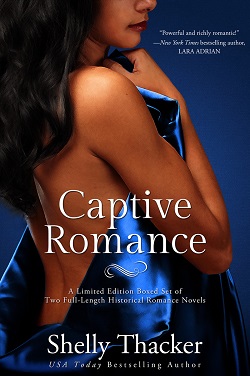 I’m excited to welcome award-winning romantic suspense author Lisa Marie Rice as my special guest today. Lisa is an American ex-pat living in Italy (sigh) and more than anyone else I know, she’s got her finger on the pulse on the European market. She just launched a series of interviews with European book bloggers on her Facebook page, and I invited her to share them here.
I’m excited to welcome award-winning romantic suspense author Lisa Marie Rice as my special guest today. Lisa is an American ex-pat living in Italy (sigh) and more than anyone else I know, she’s got her finger on the pulse on the European market. She just launched a series of interviews with European book bloggers on her Facebook page, and I invited her to share them here.
Today, Lisa chats with blogger Fabiola Chenet, co-founder of Les Romantiques, France’s premier website and webzine devoted to romance novels. Without further ado, here are Lisa and Fabiola:
LMR: Tell us about yourself and your love for books.
FC: It’s been a long time since I’ve had to introduce myself to someone. I now understand why our authors don’t like this question. My name is Fabiola Chenet and I live in France, in a city called Chartres, one hour from Paris, and I work in Paris. I have loved books ever since I learned to read, around the age of 6. Reading can bring evasion, general knowledge and an expansion of our vocabulary. That’s what I often say to my children, to make them understand how books, all books, are important. In a way, I have three jobs. I earn my living by working in a social service, I’m an author (my first romance novel will be published in the end of this year by Laska, an online indie publisher) and I work with Agnes Caubet on the website called Les Romantiques.
LMR: Tell us about Les Romantiques–its history, what you try to do in the magazine, what plans you have.
FC: The website Les Romantiques was created in 2001 by Agnes Caubet. She’s a romance reader and as a French one, she noticed that there weren’t any French-speaking websites dedicated to romance novels even though Harlequin France and J’ai Lu have been translating them since 1978 for HQN and 1991 for J’ai Lu. So when French-speaking readers wanted to have some information about romance authors and their books, they had to visit English websites. What about readers who couldn’t understand English? That’s why the website was created. Readers can find info on about 700 authors and about 2000 novels there. That includes all romance subgenres, womens’ fiction, historical novels, mysteries, romantic comedy and chick lit.
We have about 30,000 one-time visitors, about 1.9 million pages seen a month and about a thousand openings of the webzine.
In 2007, with a couple of “Romantiques” friends, we started the webzine to advance the website and to have a media material in which we could talk about our favorite literary genre, for our readers to know more about the writers, their background… We wanted a real magazine, of course, but this project would have required too much money. So we decided that a monthly free online magazine would be great. We brainstormed on what to put in it. There were three obligations: author’s interview, a file on the romance theme and an author of the month. As for the rest, readers can find the French and American publications and the reviews, a section dedicated to cinema, one dedicated to leading historical figures, one on what’s going on on our message board and news in flash.
Nikoo and James McGoldrick, aka May McGoldrick were our first interviewees. This same year, the romance genre lost a leading figure, Kathleen E. Woodiwiss, so we decided to pay homage to her. As for our first file, well, we made the term ROMANCE official for the first time in France. In September, we will celebrate our 67th issue.What we would like to do in the future (except a paper publication of the webzine) is to organize a convention on romance and women’s fiction here in France with foreign and French-speaking writers. But we need the help of our French publishers and that’s not a priority for them. Meanwhile we enjoy our romance authors when they are on vacation in our country.
We are planning to go to Berlin next year for the Loveletter Convention. And we are dreaming about attending RT Book lovers or RWA convention one day.
In majority, our partners are French publishers: J’ai Lu, Harlequin, J.C. Lattès, Belfond, Presses de la cite, Editions Charleston, Milady Romance. This year, we concluded a partnership with Le Salon du Livre de Paris (Book Fair of Paris)
LMR: You obviously love romance novels. Why? What genres do you personally prefer?
FC: Yes, definitely, I love romance novels. Because I love happy endings. J I discovered romance novels when I was 11. I remember that I was in the library searching for something new to read. I found a book with a different edge. I saw the couple on the cover, found the summary very intriguing and borrowed it. I finished it the same day. It was a HQN novel (I don’t remember the title).What I love about romance books is the relationship between the hero and heroine, how it evolves despite their ordeals or lack of comprehensions and the HEA.
I don’t have a favorite genre. I may say that I have favorite authors. Because when I love an author’s style or her characters, I will read all her books even if it’s written in another genre. Well, except when she doesn’t write happy endings, of course.
LMR: Why do French readers love American romance novels?
FC: French readers love them for two reasons. First, it’s what we have read from the beginning. I grew up reading American romance novels and I love their writing style. American authors also love to please and meet their readers. They are very easy to reach. Second, it’s because of French publishers. Some years ago, they tried to publish French-speaking romance writers but it didn’t work. They wanted those novels to be different than what we wanted to read. They didn’t understand that it was not because they consider a book to be a romance novel that we readers, we were going to read it and love it. They didn’t try to understand what we love in those novels. So they gave up with the idea that French-speaking readers didn’t know write a romance novel. That’s not true, of course. I thank two authors: Simone Elkeles and EL James. Because they both talked about romance novels here in France even though they are not published by Harlequin nor J’ai Lu. Consequently, more and more publishers and readers are interested by the genre.
We still have some way to go but I keep faith.
LMR: Do you have any message for American romance writers?
FC: I thank you all very much! Because writing a romance novel means that you believe in people, in love and in happily ever after. That’s what you describe in your books and that’s what I love.
 Special Thanks
Special Thanks
Thank you, Lisa and Fabiola (pictured at right)!
You can follow Lisa Marie Rice at her Website, Facebook or Twitter and buy her latest steamy romantic suspense, WOMAN ON THE RUN, at Amazon or B&N.
Follow Fabiola Chenet on Facebook and at Les Romantiques.
 They say that everything old is new again, and that’s certainly true in publishing, as trends come and go and then return to entertain a new generation. One of my all-time favorite romance tropes from the 1980s and 90s is gaining new popularity among today’s readers: captive-captor romance.
They say that everything old is new again, and that’s certainly true in publishing, as trends come and go and then return to entertain a new generation. One of my all-time favorite romance tropes from the 1980s and 90s is gaining new popularity among today’s readers: captive-captor romance.













 I’m excited to welcome award-winning romantic suspense author
I’m excited to welcome award-winning romantic suspense author 
